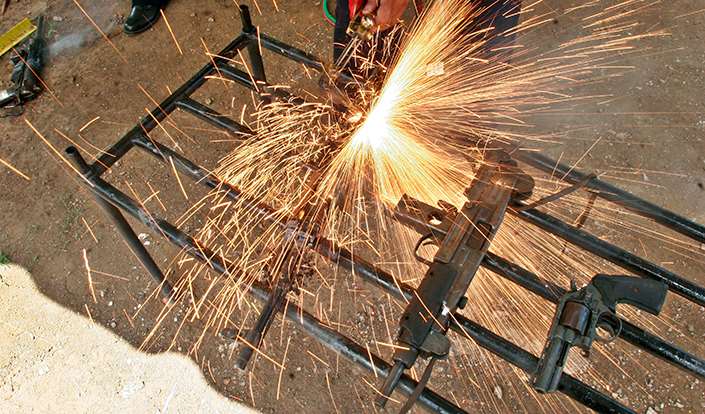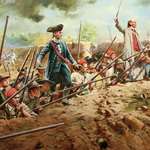
Sparks fly as a seized gun is destroyed with a torch by Nicaragua’s national police. This occurred at the inauguration ceremony for a new building constructed for the police’s weapon’s department in Managua in 2007.
When Miguel Andres, who is now 30 years old, was a democracy-advocating university student living on the edge of Caracas, Venezuela, he opted to flee the encroaching regime of Hugo Chávez to what he believed would be a freer life in his father’s native country of Colombia.
Despite the dangers in Colombia, to Andres, there was at least some comfort in being able to walk the cartel-infested, rebel-ravaged nation with a 9 mm Glock tucked in his waistband.
“When I fled Venezuela, our guns were being taken away from us. Chávez’s disarming campaign had begun,” said Andres. “We never thought this might also happen in Colombia. Unlike Venezuela, Colombia had this right as a part of its constitution. But then it did begin to happen in Colombia.”
Right now, just three countries on the planet mention the right to own arms in their constitutions: The United States, Mexico and Guatemala. The latter two, however, have chipped away at their constitutional rights so much they’ve been reduced to almost no right at all. (Something similar could be said for parts of the U.S., where Second Amendment rights have been eroded into outright infringement.) But it is important to note that, not so long ago, there were six other nations that had the right to own a gun. In 2019, The New York Times reported that Bolivia, Costa Rica, Colombia, Honduras, Nicaragua and Liberia all had protections inspired by the Second Amendment of the U.S. Bill of Rights, but that those six nations had all mostly eradicated this fundamental right.
So what happened?
Bolivia
Somewhat of a constitutional right to bear firearms was initially enacted in Bolivia on August 5, 1861. Embedded in the text was the right for Bolivian citizens to keep and bear arms, but this constitutional right was tempered, as it also gave the assembly and the president the power to restrict this provision. In October 2008, this constitutional protection was further eroded when the Bolivian government assumed direct control of firearms in its Article 298.
On September 18, 2013, the right to bear arms was formally revoked, via the Firearms, Munitions, Explosives and Other Materials Control Law. Bolivians had been sold on the notion that it would stop arms trafficking. (It didn’t.)
Ammunition “with a hollow point, expansive point, deformed point, points with scars, stripes and other special cartridges” were banned. The “possession, carry and use of a firearm with automatic shooting systems for self-defense, sport shooting and hunting” was prohibited. Citizens were barred from possessing, carrying and using suppressors.
The Bolivian Ministry of Defense announced they would supervise all activities that use any “artifacts of war.”
They didn’t stop there.
A law was put in place for the “voluntary delivery of firearms under their possession to the authorities ... .” The decree put in place a six-month grace period for gun owners to register or turn in their firearms or be subject to a “maximum six-year sentence for ownership or five-year sentence for carrying an illegal weapon, with longer sentences for military-grade weapons.”
The crackdown in Bolivia played a prominent role in inspiring Venezuela’s government to continue its crusade against civilian gun ownership. Subsequently, as an uprising stirred in the streets in late 2014, Venezuelans were left to battle their socialist dictatorship unarmed.
In late November 2020, Bolivia’s longstanding dictator Evo Morales—who signed the gun-banning edict years earlier—returned after a year in exile. He soon called for the creation of armed militias to back his corrupt bid to return to power.
Costa Rica
Then there is the idyllic Central American parcel of Costa Rica, which dabbled with gun rights in the twentieth century. Over time, the legislature has not only eliminated the constitutional provision that protected its citizens’ right to bear arms, but also has gradually tweaked the Costa Rican gun-control laws to further restrict gun rights.
“In the 1990s, the National Police started recalling the AKs. But it wasn’t until 2005 that I noticed things changing.”
Beginning with “reform” measures in 1994, a new list of contraband weapons was tossed at Costa Ricans. This included “semi-automatic long arms, whose ammunition magazine has a capacity of more than ten shots,” and strangely and arbitrarily, “any type of weapon classified as mass destruction.” Penalties for “possession of an illegal weapon” range from four to eight years.
Citizens and permanent residents can still go through the motions to legally purchase a gun, which entails a lengthy process defined by online applications, fees, documents, proof they don’t have any criminal convictions, fingerprinting and passing a psychological exam. Costa Ricans cannot own more than three handguns and can own up to three rifles for sporting use—hunting is outlawed.
Colombia
In recent years, and in cohesion with the 2016 peace deal signed with a longstanding Left-wing terrorist organization known as the FARC, citizens have been forced to surrender this means of critical self-protection. As it stands now, a citizen cannot bear arms unless the government allows it.
In 1993, a gun bill was introduced stating that “only the government can import, export, manufacture and market firearms, ammunition, explosives and their components, arms making equipment, and all activities thereto pertaining.”
In late 2015, the hammer came down. Bogotá implemented a nationwide injunction against the carrying of firearms. A few weeks later, in January 2016, then-President Juan Manuel Santos declared that the executive ruling would continue to at least the end of the year.
Of course, it didn’t end there.
Before the national ban, there had been similar restrictions in specific pockets of the country. These were typically put in place for just a few days or weeks. And then, before Colombians knew it, they were all subject to the prohibition.
Yet, even as citizens were told they could no longer carry, about 2.5 million illegal firearms were estimated to be in circulation in Colombia, most of which were owned by organized criminal groups.
Many Colombians didn’t stay quiet. The resentment became so loud, in fact, that in 2018, Colombia’s President Iván Duque Márquez loosened the reigns. He announced that civilians could again carry guns, provided they were issued by the military.

Honduras
Meanwhile, in Honduras, the law allowed: “Every person, in the exercise of their civil rights, may request a maximum of five (5) licenses for the possession and carrying of up to five (5) firearms by submitting an application.”
The Central American nation of just below 10 million was once far freer than it is today. But under the umbrella of a campaign to stamp out gun running and violence, this has changed.
The push by gun-control proponents in recent decades has been mostly successful. Honduras enacted a ban on both open and concealed carry in 2007.
But a 2017 analysis by the mapping and spatial-software firm ESRI concluded that gun-control measures are “largely ineffective because the government cannot issue force over the criminal groups,” who still “hold a piece of power” in ensuring the black market “flourishes selling guns and ammunitions” across the country.
Still, many on the Left in Honduras argue that five guns are too many for any citizen to own, as they claim that such “lax laws” contribute to high murder rates.
Nicaragua
In Nicaragua, the 1987 constitution—birthed in the aftermath of the Contra War—provided citizens “the right to arm themselves in defense of their sovereignty, independence and revolutionary gains,” deeming it the “duty of the state to direct, organize and arm the people to guarantee this right.”
“In the 1990s, the National Police started recalling the AKs,” one expat located in the capital of Managua said. “But it wasn’t until 2005 that I noticed things changing.”
Sweeping new firearms regulations were then enacted; ultimately, gun-control laws began dictating everything from what a citizen can acquire and carry to what type of ammunition they could purchase.
Nicaraguans often have to hire an attorney to guide them through the process of attempting to use this freedom, which also involves physical and psychological examinations and standardized firearms-safety instruction.
But it was in the early summer of 2018 when the full brunt of what it means to be a defenseless citizen was exposed. Thousands took to the streets in protest of the long-running, corrupt dictatorship of President Daniel Ortega and his wife Rosario Murillo, who was appointed vice president more than a decade earlier. The demonstrators were met with gunfire. Hundreds of pro-democracy demonstrators lost their lives in various protests.
Liberia
And then there is the only non-Americas nation: the West African country of Liberia. Its right to bear arms was inked constitutionally in 1847. It has subsequently been scrubbed out.
In 2006, then-President Ellen Johnson Sirleaf signed an executive order initiating a “total ban on firearms,” and mandating that all United Nations’ member states “should take the necessary measures to prevent the sale or supply to Liberia” of firearms and “related materials of all types.”
“No individual, group, organization or entity other than the Government of Liberia may own, possess or cause to be brought into Liberia any firearm of any type, caliber or design or any ammunition or parts for any firearm, or any tooling equipment intended for the purposes of manufacture, assembly or re-tooling of firearms of any type,” the order stated.
A decade later, the “Liberia Firearms and Ammunition Control Act of 2015,” complete with a draconian legal framework for regulating the possession and use of small arms and light weapons in the country, was passed into law by the National Legislature.
With that, “as part of its core function to control, regulate and prevent the proliferation of Small and Light Weapons in Liberia,” authorities were issued powers to force more-stringent registration and licensing procedures.
Control came in other ways, including the declaration that “no person shall manufacture, or assemble any firearms or ammunition, or component parts thereof without the consent” and “all such repairs shall be done at public armories or arsenals established for the purposes of the armed forces.”
•••
When we drill down into those other nations that let their constitutions be amended and slowly eroded, it is critical to note that it didn’t happen all at once. It was often a slow chipping away with gun-control enacted by politicians and military figures. It was also propelled by media calls for fighting crime by disarming law-abiding citizens, not the criminal elements in society.
Then, one day, citizens awoke to the notion that they were unarmed, yet the criminal enterprises and authoritarian regimes were not. By then, it was too late.
Note: Many of the quotes in the article are translations.

































